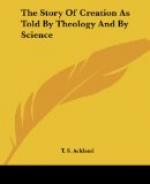The Days. The rocks.
1. Creation of light.
2. Creation of the Atmosphere.
|The earth covered with water |Laurentian. 3.—| [implied]. |Cambrian. |Upheaval of land. ----|Silurian. |Creation of terrestrial Flora. |Devonian. |Carboniferous.
4. The sun and moon made “Luminaries.”——|Permian. |Triassic.
|Triassic. 5. Creation of birds and reptiles ——|Jurassic. |Cretaceous, |Eocene.
6.—|Creation of land animals. ——|Eocene. |Creation of man. |Miocene. |Pleiocene. |Post Tertiary.
Concurrent events.
Laurentian: Upper Laurentian unconformably placed
on Lower
Laurentian, which contains Eozoon Canadense.
Cambrian: Traces of volcanic action. Ripple marks indicating land.
Silurian: Earliest fish.
Devonian: Earliest land plants.
Carboniferous: The coal measures. Peculiarly
abundant vegetation.
Earliest known reptile.
Permian: Foot-prints of birds and reptiles—with a few remains of the latter.
Jurassic: The first bird, and the first mammal. The age of reptiles.
Cretaceous: Reptiles passing away, mammalia abundant and of large size.
Post Tertiary: Human remains found only in the most recent deposits. In this table we see certain points of strongly-marked coincidence:—
1. The oldest rocks with which we are acquainted—the Lower Laurentian [Footnote: The age of granite is uncertain.—Lyell’a Student’s Geology, p. 548.]—were formed under water, but had begun to be elevated before the next series, the Upper Laurentian, were deposited. Ripple marks are found in the Cambrian group [Footnote: Ibid. p. 470], indicating that the parts where they occur formed a sea-beach, and, consequently, that dry land was in existence at that time.
2. The earliest fossil land plants as yet discovered are found in the Devonian series, and they gradually increase till, in the Carboniferous strata, they attain the extreme abundance which gave rise to the coal measures.
3. The age of reptiles. The earliest known reptile is found in the Carboniferous strata. In the Permian and Triassic groups the numbers gradually increase, till in the Lias, Oolite, and Cretaceous systems, this class attains a very great development both numerically and in the magnitude of individual specimens. During the same period the first traces of birds are found. The first actual fossil bird was found in the upper Oolite.
4. The age of mammalia. The first remains—two teeth of a small marsupial—were discovered in the Rhaetic beds of the Upper Trias, and a somewhat similar discovery has been made in beds of corresponding periods in Devonshire and North America. During the subsequent periods the numbers slowly increase, till in the Tertiary strata the mammalian becomes the predominant type.




